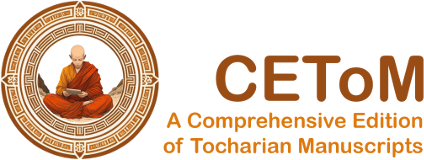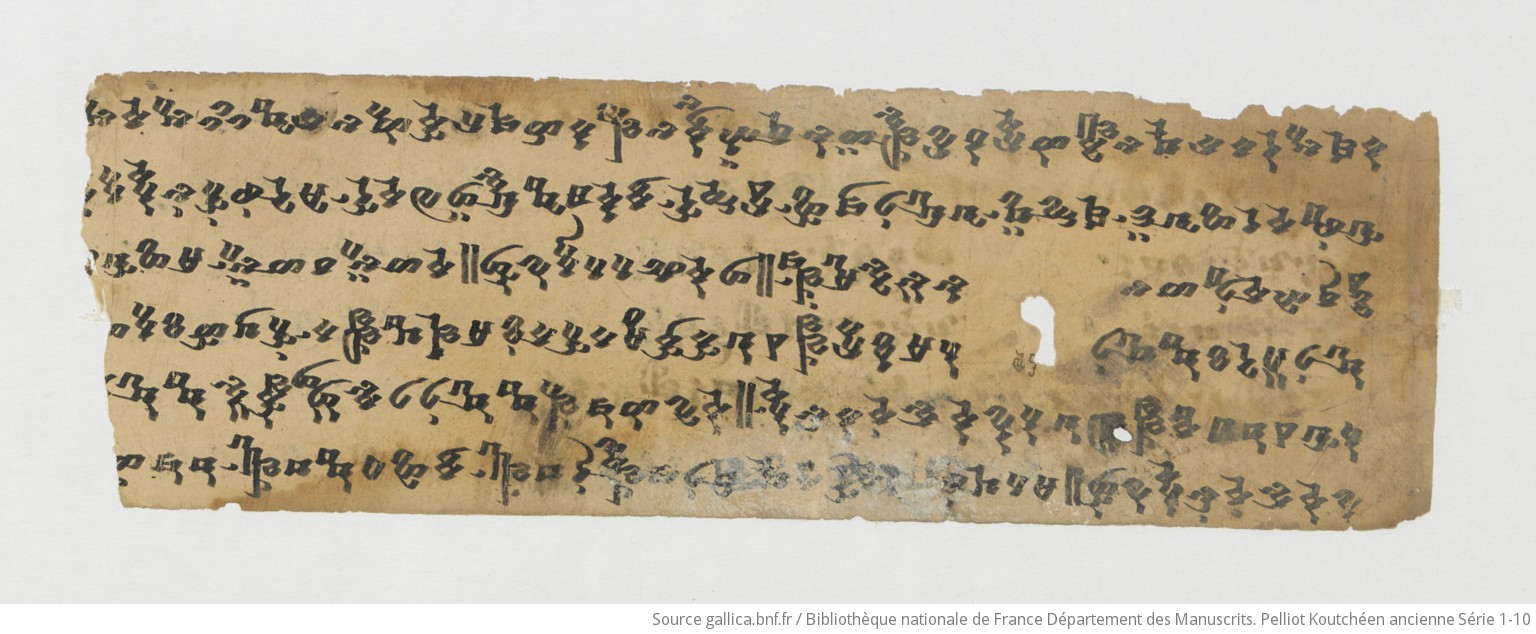PK AS 3B
| Known as: | PK AS 3B; Pelliot Koutchéen Ancienne Série 3B; P 2 |
|---|---|
| Cite this page as: | Georges-Jean Pinault; Melanie Malzahn (collaborator); Michaël Peyrot (collaborator). "PK AS 3B". In A Comprehensive Edition of Tocharian Manuscripts (CEToM). Created and maintained by Melanie Malzahn, Martin Braun, Hannes A. Fellner, and Bernhard Koller. https://cetom.univie.ac.at/?m-pkas3b (accessed 01 Jul. 2025). |
Edition | |
| Editor: | Georges-Jean Pinault; Melanie Malzahn (collaborator); Michaël Peyrot (collaborator) |
| Date of online publication: | 2014-02 |
Provenience | |
| Main find spot: | Dunhuang |
| Expedition code: | 3510, 50 |
| Collection: | Bibliothèque nationale de France, fonds Pelliot Koutchéen (Paris) |
Language and Script | |
| Language: | TB |
| Linguistic stage: | classical |
| Add. linguistic characteristics: | late |
| Script: | classical |
Text contents | |
| Text genre: | Literary |
| Text subgenre: | Medicine/Magic |
| Verse/Prose: | prose |
Object | |
| Manuscript: | PK AS 3 |
| Material: | ink on paper |
| Form: | Poṭhī |
| Size (h × w): | 8.8 × 27.1 cm |
| Number of lines: | 6 |
| Interline spacing: | 1.4 cm |
Images
Images from gallica.bnf.fr by courtesy of the Bibliothèque nationale de France, Département des Manuscrits, Pelliot koutchéen.
Transliteration
| a1 | s̝pa sā[ṃ] tke ya mi ne • to meṃ no po kkā ka ṣo ta rnma tā ko kne • se saṃ ni pā ti¯ ¯k• ka rsa na lle • dva vra ṇi pi leṃ tse ṣo tri pa – /// |
|---|---|
| a2 | ña ke no saṃ tke nta we ñau • i sta kyā mo ṣṣi li la ko¯ ¯yä ku ñci ta ṣṣe ṣa lype e neṃ ya ma s̝s̝a lle ke ne kaṃ ñe śwe le – /// |
| a3 | ñci¯ ¯ṣṭä • pi ssau • śa ba ra • ○ lo tra śwa śko • ku rka ma ṣṣi ptsā¯ ¯ñä • ca ndāṃ • śa kkā¯ ¯r• mpa ṣe sa wa ltsa na lle [na] /// |
| a4 | tsi śpā lmeṃ • || pa tta¯ ¯ṅk• • ○ pi ssau śa ba ra lo dra a ñcāṃ • gai ri¯ ¯k• ya sa rsa sai tsi śpā lmeṃ • || ka ṭpa¯ – /// |
| a5 | śa ba ra lo dra • lyka śke tsa tsā pa rya sa rsa sai tsi • || śa ba ra lo dra • u ppā la ṣṣa na pi ltā sa • dha nya mā¯ ¯s̝[•] /// |
| a6 | śva ka te • la ksa ña klau tso • ke wi ye me [lte] [ṣṣe] ṣpe¯ ¯l• te śā rka tnā lle ka mpā sa ṣṣe śwe le sa śa nma s̝aṃ lle ya /// |
| lf | [70] 5 |
| b1 | rw[e] ke tsā kaṃ sāṃ tke we ñau || śa ta pu[¯] [¯]s̝[p][•] – [ka] [ro] [ka] [ṣṣu] [pi]¯ ¯l• ma lkwe¯ ¯r• ṣa lype • ku ñci ta ṣṣe ṣa lype • ṣe me y[ä] /// |
| b2 | te po e ṣe pa kṣa lle [lo] pe • te rwe ke tsā kaṃ ne sā tke • || ke wi ye me lte ṣṣe ṣpe¯ ¯l• la ksa ññai klau tsai ṣṣe ṣpe¯ ¯[l] /// |
| b3 | ṣpe¯ ¯l• gai ri ka ṣṣe ṣpe¯ ¯l• ○ te śā rka tnā lle e pe no kro śca na to na¯ ¯k• śā rlu pṣa llo na • toṃ pra yo ka nta [y]· /// |
| b4 | dvi vra ṇi ka¯ ¯lp• ya sa ○ rsa sai tsi śpā lmeṃ • || ña ke bhū ta ta ntra we ñau || ka ya¯ ¯stä va ya¯ ¯stä • śā ñca po – /// |
| b5 | po¯ ¯s̝p• ka ra ñca pi¯ ¯jä • a ṅwa¯ ¯ṣṭä • pi ppā¯ ¯l• mra ñco • tvā ṅka ro • ku rka ma ṣṣi ptsā¯ ¯ñä o ka ro • śi ri¯ ¯s̝• toṃ saṃ tke nta – /// |
| b6 | ne a sta re na nā ṣṣu sa klyi ye tkā ce rwā ltso¯ ¯yä se cu¯ ¯rṇä kuse sa ltu rna yā mu tā ko yte sa nā ṣṣi i sta ka s[t](·) |
Transcription
| lf | 70-5 |
Translation
| a1 | and ... one should make the remedy of that. And thereupon call the symptoms with respect to the gangrene (?)! This [= boil] [is] to be known [as] Sāṃnipātika [= caused by a combination of disorders]. L(ook) at the symptom of the Dvivraṇīya [= caused by the two kinds of wounds] boil! ... |
|---|---|
| a2 | And now I will tell the remedies. As soon as boils emerge, one should immediately examine [them]; Sesame oil is to be put on [them], [and it is] (to be bound with) a cotton bandage. |
| a3 | Hedyotis umbellata, aneth, Symplocos racemosa, Berberis aristata, saffron stigmas, sandalwood: [this is] to be crushed together with sugar ... |
| a4 | to (staunch) [it] perfectly. Caesalpina sappan, aneth, Symplocos racemosa, collyrium, yellow arsenic: [this is to be used] with blood to staunch [it] perfectly. Bandages (??) (have to be made) ... |
| a5 | Symplocos racemosa: [once] finely crushed, [this is to be used] with blood to staunch [it]. Symplocos racemosa, lotus leaves, [a measure of the size of] Dhānyamāṣa ... |
| a6 | Withania somnifera (??), gill [lit. fish ear], cow dung pellet: this [is] to be strewn over [it and] to be bound with a ... bandage ... |
| b1 | [If] (the wound?) would bite the terwe of someone, I will tell the remedy [for that]. Anethum sowa, Acorus calamus, Costus speciosus, the fruit of Aegle marmelos (?), milk, oil, sesame oil: by one (measure this is to be crushed). |
| b2 | All this [is] to be cooked together. [If] the wound (?) bites the terwe of someone, [this is] the remedy. Cow dung pellet, gill [lit. fish ear] pellet, |
| b3 | ... pellet, saffron pellet: this is to be strewn over [it], otherwise these very same [ingredients] are to be smeared cold over [it]. These treatments have (to be made as) |
| b4 | a Dvivraṇīya cure [= related to the two kinds of wounds]. [It is to be used] with blood to staunch [it] perfectly. Now I will tell the Treatise about demons [= Bhūtatantra]. Cardamoms, small cardamoms, Dalbergia sisu, ... |
| b5 | and ..., seed of Pongamia glabra, Ferula asa foetida, Piper longum, Piper nigrum, ginger, saffron stigmas, Acorus calamus, Acacia Lebbek: these remedies ... |
| b6 | pure; [only] a cleaned woman [or] daughter should crush [them]. This [is] the powder. If somebody has been made salturna [= bewitched??], he should bathe with it. Immediately (he will become) pure ... |
Other
| a2 | Now I will state the remedies. (Peyrot 2013b: 657) |
|---|---|
| b1 | I will now state the remedy, a salve for whom the terwe bites. (cf 306) (Peyrot 2013b: 704) |
| b2 | [This is] the remedy, a salve for whom the terwe bites. (cf 306) (Peyrot 2013b: 704) |
| b4 | Now I will speak of the Bhūtatantra [book of (demoniac) beings]. (52) (Peyrot 2013b: 657) |
Commentary
Remarks
| An almost complete leaf, about 5 to 6 akṣaras are missing on the right margin. The leaf number is written inside the string hole space, which is rather [7]5 and not 55 (as per Filliozat). This may be a typo in Filliozat 1948: 51. |
Linguistic commentary
| Note saitsi for saintsi. | |
| n1 | ṣotarnma seems to be a late plural form of ṣotri 'mark' (instead of ṣotruna). |
| n4 | Note the virāma sign separating the case suffix in śakkār\•mpa. |
Philological commentary
| n2 | A separation tāk okne is also possible, but not very likely. Both forms would be hapax; to be sure, kok may be interpreted as a wrong Sanskritization of a Prakrit form from Skt. kotha- ‘sore, gangrene' or 'affliction of the eye' (cf. Monier-Williams 1899: 313a). |
|---|---|
| n3 | One has to read ṣili, which ought to be a mistake for pili. Sieg's correction of pili into pile is speculative; one can accept pili as nom. plural and construct it with yāmoṣ in a subordinate clause. |
| n5 | śabaraloträ is a single word, which has been wrongly separated by a dot. |
| n6 | The remains of the last akṣara permit a reading kaṭpa(l)\ or kaṭpa(ñ)\. The closest Sanskrit word would be khaṭvā- 'kind of bandage', the borrowing of which would give the nom.pl. |
| n7 | The reading śvakate is superior to ścakate and allows a restoration (a)śvakate to be connected with Skt. aśvagandha- 'Withania somnifera' (otherwise attested by the form TB aśvakānt). |
| n8 | kampāsäṣṣe cannot simply mean 'cotton'; the form kampās in THT 337 a 4 is a mistake for kampāl warranted by the parallel text PK AS 18A and note that TA kappās (via Middle Indic kappāsa- from Skt. karpāsa ‘cotton' refers to the cotton plant rather that the material. On the other hand, the woven cotton is called kenek, TA kanak. |
| n9 | lope is rather a borrowing from Skt. lopa-, which can have the meaning 'hurting, breaking, violation' than a late form of a Tocharian abstract laupe from lup- 'to smear'. Consequently, terwe is rather the direct object (and not an adverb, as supposed by Sieg), whis is proven by the object construction with -ne in the parallel passage in b2. It may refer to a part of the skin (?). Adams 2013a: 324 interprets the form as 'kind of snake' and translates b2 "I will speak now of a salve, a medicine for whom the terwe bites", but this does not work syntactically. |
| n10 | Instead of naṣṣū one has to read kaṣṣu. The following akṣara before the l\ is hardly a ‹ba›, and it cannot be ‹bā› in the first place, because the long ā-vowel would be written to the right and not on top of the sign. pil can be Skt. bilva- 'Aegle marmelos fruit'. |
| n11 | po is rather the end of an ingredient, and not the word po 'all'. |
| n12 | The process of crushing has apparently to be done by a young girl before her maturation, and if an adult woman has to do it, one has to make sure that she is devoid of menstrual blood. |
| n13 | The reading sal [ṣa]rn[e] by Sieg is impossible, the manuscript has salturna of unknown meaning. |
References
Edition and translation
Filliozat 1948: 51-53; Sieg and Thomas 1954: 68-69
Translations
Peyrot 2013b: a2 (657), b1 (704), b2 (704), b4 (657)
Bibliography
Adams, Douglas Q. 2013a. A dictionary of Tocharian B. Revised and greatly enlarged. 2nd ed. 2 vols. Amsterdam/New York: Rodopi.
Filliozat, Jean. 1948. Fragments de textes koutchéens de médecine et de magie. Texte, parallèles sanskrits et tibétains, traduction et glossaire. Paris: Librairie d’Amérique et d’Orient Adrien-Maisonneuve.
Monier-Williams, Monier. 1899. A Sanskrit-English dictionary. Etymologically and philologically arranged with special reference to cognate Indo-European languages. new edition, greatly enlarged and improved, London: Clarendon Press (several reprints).
Peyrot, Michaël. 2013b. The Tocharian subjunctive. A study in syntax and verbal stem formation. Vol. 8. Brill’s Studies in Indo-European Languages & Linguistics. Leiden/Boston: Brill.
Sieg, Emil, and Werner Thomas. 1954. “Die medizinischen und tantrischen Texte der Pariser Sammlung in Tocharisch B.” Zeitschrift für Vergleichende Sprachforschung 72: 63–83.




